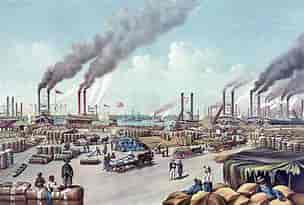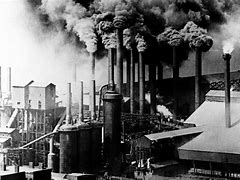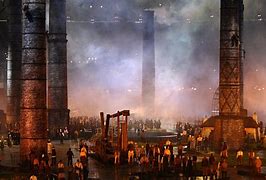Introduction
The Industrial Revolution was a pivotal period in human history, marking the transition from manual labor to machine-based manufacturing and transforming the way societies functioned. This revolution, which began in the late 18th century in Britain, had far-reaching impacts on economics, politics, and social structures. In this article, we will delve into the key aspects of the Industrial Revolution, its causes, consequences, and how it continues to shape our world today.
What Was the Industrial Revolution?
Definition and Timeline
The Industrial Revolution was a period of significant economic, technological, and societal change that began in Britain around the 1760s and spread to other parts of the world over the next century. It was characterized by the development of new machines and factories, the use of steam power, and the introduction of new manufacturing technologies.

Key Innovations
- Steam Engine: Invented by James Watt, the steam engine revolutionized industry by providing a reliable and consistent source of power.
- Spinning Jenny: Developed by James Hargreaves, this machine enabled the simultaneous spinning of multiple spindles of yarn, significantly increasing textile production.
- Power Loom: Invented by Edmund Cartwright, the power loom automated the weaving process, further boosting textile production.
Causes of the Industrial Revolution
Technological Advancements
Technological innovations were a primary driver of the Industrial Revolution. Improvements in metallurgy, the development of new machines, and the harnessing of steam power created the conditions for mass production and industrial growth.
Economic Factors
- Capital Investment: The availability of capital from wealthy merchants and the development of banking systems allowed for the financing of new industrial ventures.
- Natural Resources: Access to abundant natural resources such as coal and iron was crucial for the production of machinery and fuel.
Social and Political Changes
- Population Growth: An increase in population provided a larger workforce, which was essential for the growth of industries.
- Government Policies: Favorable government policies, such as the enclosure movement in Britain, helped to consolidate land and create a mobile workforce.
Impact on Society
Urbanization
The Industrial Revolution led to a significant shift from rural to urban living. As factories grew, people moved from countryside to cities in search of employment, leading to the development of new urban centers.
Changes in Work Patterns
- Factory System: The introduction of the factory system replaced traditional craft-based production with machine-based manufacturing, leading to a more regimented and disciplined workforce.
- Division of Labor: The concept of division of labor, popularized by Adam Smith, increased efficiency and productivity in factories.
Social Inequality
The Industrial Revolution exacerbated social inequality. Factory owners and managers accumulated wealth, while many workers faced poor working conditions, long hours, and low wages.

Economic Impact
Industrial Growth and Productivity
The Industrial Revolution led to a significant increase in industrial production and productivity. New machines and factories enabled mass production, reducing costs and increasing the availability of goods.
Global Trade
The revolution facilitated global trade by improving transportation networks, such as the construction of canals and railways, and the development of steam-powered ships.
Environmental Impact
Pollution and Resource Depletion
The increased use of coal and other fossil fuels led to significant environmental pollution. The Industrial Revolution also resulted in the depletion of natural resources and the degradation of ecosystems.
Health Impacts
The poor working conditions and environmental pollution had severe health impacts on workers, including respiratory diseases and other industrial-related illnesses.
Political Impact
Rise of Capitalism
The Industrial Revolution solidified capitalism as the dominant economic system in many parts of the world. It led to the emergence of a new class of industrial capitalists and the growth of consumer markets.
Labor Movements
The harsh conditions faced by workers led to the formation of labor movements and trade unions, which fought for better working conditions, higher wages, and workers’ rights.
Legacy of the Industrial Revolution
Modern Industrial Society
The Industrial Revolution laid the foundation for modern industrial society. It set the stage for subsequent technological revolutions, including the digital revolution of the late 20th century.

Globalization
The Industrial Revolution was a key factor in globalization. It established global trade networks and set the stage for the interconnected world economy we see today.
Conclusion
The Industrial Revolution was a transformative period in human history, marked by significant technological, economic, and social changes. While it brought about immense economic growth and industrial development, it also had profound social and environmental impacts. Understanding the Industrial Revolution helps us appreciate the complexities of modern society and the ongoing evolution of our global economy.
FAQs
What were the main causes of the Industrial Revolution?
The main causes of the Industrial Revolution included technological advancements, economic factors such as capital investment and access to natural resources, and social and political changes like population growth and favorable government policies.
How did the Industrial Revolution impact urbanization?
The Industrial Revolution led to significant urbanization as people moved from rural areas to cities in search of employment in factories, resulting in the growth of new urban centers.
What were the key innovations of the Industrial Revolution?
Key innovations included the steam engine, spinning jenny, and power loom, which revolutionized manufacturing and production processes.
How did the Industrial Revolution affect the environment?
The Industrial Revolution led to significant environmental pollution due to the increased use of fossil fuels, resource depletion, and degradation of ecosystems.
What was the impact of the Industrial Revolution on labor?
The Industrial Revolution led to the development of the factory system, division of labor, and poor working conditions for many workers, but also spurred the formation of labor movements and trade unions to advocate for workers’ rights.
How did the Industrial Revolution influence globalization?
The Industrial Revolution established global trade networks and facilitated the growth of international trade, laying the groundwork for the interconnected global economy of today.


